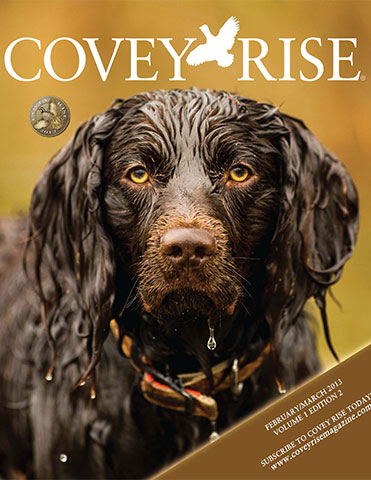My heart skipped a beat when my wife told me she loved Albert. He was a young, muscular, good-looking tricolor setter of North Carolina quail stock, part of the field-dog rotation at The Webb Farm. Bill Webb owned him, Wade Meacham trained him and Kenny Rabb hunted him. One day, Albert tore a ligament, and despite surgery he would never get back to the rigorous hunting schedule required of him at the farm.
Bill knew the setter still had a lot more bird-chasing years in him. If Albert were worked out regularly and hunted for shorter periods of time, he’d be just fine. And so it came to be during our annual winter hunt at The Webb Farm. Bill could think of no better fit for Albert since we work our dogs regularly and each of our coverts takes about an hour to hunt. We were shoeins for the Adopt Albert program, and everyone wanted the dog to find a home in our kennel – except for me.
How do you take a big running dog whelped on fields full of wiregrass, lovegrass, milo and bicolor lespedeza and get him to like the tight, harsh New England coverts? The term “exercise in futility” came to mind, and I was concerned that I could take the dog out of the South but that I wouldn’t be able to take the South out of the dog.
Any protest I may have had was over by the time my daughter met Albert. She liked the tan and black patches around his eyes, and she smiled when he flopped into her lap. I folded like a house of cards, and we picked up Albert on an 85-degree, Carolina-blue spring day. Love was in the air.
The dog adjusted just fine to his new life above the Mason-Dixon Line. I ran him in the woods, we did casting two-a-days to shorten his range and he showed a lot of promise. He was a smart, experienced, well-trained gun dog, and it helped that our summers reminded him of his days on the piedmont. Albert proved that you can teach an old dog new tricks.
There was just one hitch. As horses balk at jumping fences, field dogs usually reject thick cover. Unless it’s in their blood, hat dog – or for that matter, what hunter – would trade the softness of wheat, milo, and barley fields for the impenetrable white birch runs, the stabbing Hawthorne tines, the shrouds of bull briars, and the snarling tangles of raspberry vines? Dogs usually don’t volunteer to run through that kind of mess, and Albert was no exception.
Anything done in moderation shows a lack of interest, so I tried a mentorship program. I ran Albert with one of my cover dogs, which made about as much sense as socks on a rooster. I had one dog in the cover and one dog in the field, and I was in the middle. If you’re wondering about that patch of gray hair on my head, it blossomed on that day.
I like to build on successes, and Albert’s came slowly. His first win came in the Ed Gray covert. The covert was one of Ed’s favorites, and it is a delightful old farm with a hillside slope that was chock-a-block with apples, high-bush cranberries and haws so thick you could barely see daylight on the other side. A river runs through the bottom, and alder and white birch are everywhere. On a good day, you could shoot grouse on your way down to the bottom, and on a great day you’d find a few woodcock. A tremendous field separated the two sections, and that was where Albert flash-pointed his first grouse. Later on I shot a pair of timberdoodles over his points, and my friend Cabe shot a few woodcock over Albert in the King’s Covert, too. But when we were slow to find birds, Albert headed straight for the nearest field.
Albert didn’t much care to get shredded and stabbed by the bush and briars. When it’s hot and the birds are tucked away in the shade and the moisture of the thickest of thick coverts, you’ve got to have the patience of Job to work your way through. At the end of a season, my double-faced chaps are shredded and I’ve got scars on my face and wrists, but my scrapes pale in comparison to a dog on the ground. Albert wanted no part of the jungle, and the only way I could get him into the coverts was to show him a benefit. That magic arrived when the woodcock flights were heavy.
I looked forward to the full moon at the end October. The temperatures would be lower, and a killing frost would open up the woods. The heavy west-northwest winds would knock down the leaves from the trees, and there would be more chalk on the ground than on a teacher’s blackboard. I decided to put him in Freight Train, my best covert, and hoped that a flight of woodcock had dropped in for a visit.
Albert was cranked and ran over the first few before he settled down and got to work. It helped that the woodcock were spread perfectly throughout the covert. His casting tightened up to a 30- to 35-yard range on the whistle, he figured out the difference between ground and body scent and he found the birds where they always are – right in the thickness. Repetition makes the master, and after 24 birds in under an hour, Albert was well on his way to becoming a New England cover dog.
Birds make a bird dog, and for the rest of the season old Albert ran as good as my other setters, Ocracoke and Rowdy. Sometimes he ranges a little too far, and when he does he stands back off the bird a ways to let me catch up. When I get done zigzagging through the woods, he’ll reposition closer toward the bird; when I find a space open enough to take a shot, he’ll lock right up. Albert has added grouse and woodcock to his repertoire, but he’ll forever be a Southern gentleman, just the way we love him.

